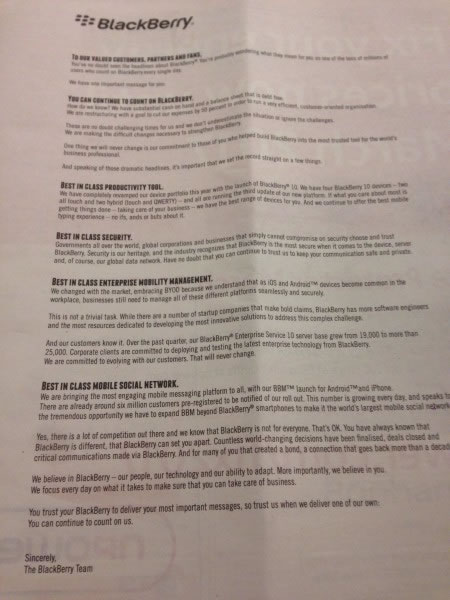Randy Liedtke came up with a prank that’s equal parts eeeevil and clever: baking cookies that look like iPhones. He goes driving, holds them as if they’re the real thing, and if a cop pulls him over, he takes a bite and asks if cookies are against the law.
The Rise and Fall of BlackBerry: An Oral History is the cover story of this week’s Bloomberg Businessweek. The dead-tree edition of the magazine should be on stands by now, and the article itself has been online since Saturday. If you follow it with the Globe and Mail’s investigative report titled Inside the fall of BlackBerry: How the smartphone inventor failed to adapt (co-written by my friend and former Crazy Go Nuts University schoolmate Sean Silcoff, and published in late September), you’ll have a pretty complete picture of what happened to the company that once made mobile devices that were considered must-haves.
In the video below, Bloomberg’s Felix Gilette talks about the making of the article, as well as one of the most telling quotes, which came from Vincent Washington, who was RIM’s, and later, BlackBerry’s senior business development manager from 2001 to 2011:
One thing we missed out on was that Justin Bieber wanted to rep BlackBerry. He said, “Give me $200,000 and 20 devices, and I’m your brand ambassador,” basically. And we pitched that to marketing: Here’s a Canadian kid, he grew up here, all the teeny-boppers will love that. They basically threw us out of the room. They said, “This kid is a fad. He’s not going to last.” I said at the meeting: “This kid might outlive RIM.” Everyone laughed.
The perspectives in Bloomberg Businessweek’s article come from reasonably high-up BlackBerry/RIM employees, but not any of the CEOs: not the original duo of Lazaridis and Balsillie, nor replacement CEO Thorsten Heins, nor current interim CEO John Chen.

…and that you’re dismayed because President Obama hasn’t dropped by to show his support. I thought I’d share this photo of Steve Buscemi playing the world’s tiniest violin, just for you.
We’ve all had some form of this experience (sometimes, I need to flip the USB plug only once):

Apple’s solution to the problem was the Lightning connector, a beautiful and proprietary 8-pin connector that can be inserted with either side facing up, and for which they’d be very happy to charge a licensing fee for building devices that are compatible with it:

For people who like Apple devices and for whom good design is important, Lightning is worth the price. For those who thought that beige desktops and big grey laptops were just-fine-thank-you-very-much, their reaction’s more like this:

It looks as though good ol’ USB will finally follow suit. Brad Saunders, chair of the USB 3.0 Promoter Group says that the proposed USB Type-C connector — an addition to the USB 3.1 spec — will be about the size of a Micro USB plug and be reversible. The spec for the connector is expected to be finalized “by the middle of 2014”, presumably in order to give manufacturers time to ramp up for the holiday season.
According to Intel’s Alex Peleg:
“[The USB Type-C connector] will enable an entirely new super-thin class of devices from phones to tablets, to 2-in-1s, to laptops to desktops. This new industry standards-based thin connector delivering data, power, and video is the only connector one will need across all devices.”
Let’s hope it’s prettier than the current Micro USB 3 connector. It would appear that it was “designed” by people who, to use an expression I heard ages ago, “have the visual sense that God gave oysters”:

While it remains to be seen how the connector standards will turn out, one thing is clear: I’ve got boxes and boxes of cables that are soon to become obsolete.

Japan is big on both weirdness and mobile phone culture, so it’s not surprising that they occasionally combine the two. Ladies and gentlemen, I give you…Kitan Club phone stands!

They’re adorable and odd in that way that only the Japanese can make them. The cat stands attach to the back of your mobile phone — or keitai in Japanese — with a suction cup, holding it upright on a table or some other handy level surface.

If you’d rather have a stand with the cat holding up your phone with its back, Atlas-style, Kitan Club’s got you covered too…

You can find Kitan Club stands on sale on eBay, where you’ll be treated to oddball photos of Kitan Club stands posed in “action shots”, like the one below:
 I received BlackBerry’s open “We’re Not Dead Yet!” email this morning. Two notable things distinguish it from the consumer-focused open letter for which they bought ad space in several major newspapers in October (see and click on the photo to the right):
I received BlackBerry’s open “We’re Not Dead Yet!” email this morning. Two notable things distinguish it from the consumer-focused open letter for which they bought ad space in several major newspapers in October (see and click on the photo to the right):
- This open letter, is aimed squarely at enterprise decision-makers who may have been influenced by recommendations like Gartner’s to ditch the platform, because any hope of recovery was exhausted long ago.
- Unlike the previous letter, which was signed by “The BlackBerry Team”, this one was signed by BlackBerry interim CEO John S. Chen, a man in a very unenviable position. I’d normally say “I hope he’s getting danger pay”, but based on the deals these guys typically get — remember Thorsten’s golden parachute? — it’s not necessary.
The main points called out in the letter in “heading 2” text are:
- “We are very much alive, thank you”: They reassure readers that Fairfax’s strategic investment is a vote of confidence in the company, which is going to back its enterprise roots in four specific areas: “handsets, EMM solutions, cross-platform messaging, and embedded systems”. They end with “In short, reports of our death are greatly exaggerated.”
- They manage all devices, not just BlackBerry: The notable points they put forth are that “Our EMM customer base is much larger than any of the other vendors in the Gartner Magic Quadrant for Mobile Device Management” and more tellingly, “We have substantial cash and are not a small VC-backed “pure play” MDM player seeking additional funds every year.”
- “Security is not debatable – regardless of the device”: Government agencies and armed forces trust their security.
- They’re more than devices: they’re enterprise mobility. What a difference six years make: the final section of the open letter begins with “We know that BlackBerry devices are not for everyone. That’s OK”, and reinforces the fact that they also sell an MDM solution that you can use with any device.
I’ve been doing a fair bit of work with a company specializing in helping enterprises manage their employees’ mobile devices, both corporate- and employee-liable, and they’ve all been saying the same thing: that 2014 will be all about ditching BlackBerry and BES for some combination of Android, iOS, and Windows Phone, along one or more third-party MDM solutions. BlackBerry’s open letter is clearly meant to help quell that exodus. The message is clear — we’re now an MDM company that just happens to make smartphones — but it’s likely to be drowned out by MDM vendors and support businesses hoping to cash in on those lucrative migrate-us-the-hell-away-from-BlackBerry contracts.
In honor of BlackBerry’s “Not Dead” messaging, here are two Monty Python skits that immediately came to mind when I read the open letter — the “Bring Out Your Dead” bit from Monty Python and the Holy Grail…
…and the “Dead Parrot” sketch from the TV show:
For the completists, here’s the text of the open letter:
An Open Letter to Customers
To our valued enterprise customers and partners,
You’re hearing a lot of noise in the market about BlackBerry®. MDM vendors are undoubtedly inviting you to webinars and enticing you to switch off your BES.
We want to set the story straight about BlackBerry in the Enterprise, both for our existing customers and for those about to implement BYOD and MDM.
We are very much alive, thank you
Our “for sale” sign has been taken down and we are here to stay. BlackBerry recently announced it has entered into an agreement to receive a strategic investment from Fairfax Financial and other institutional investors, which represents a vote of confidence in the future of BlackBerry.
The investments you’ve made in BlackBerry infrastructure and solutions are secure.
I will keep the lines of communication open as we navigate through this transition.We’re going back to our heritage and roots – delivering enterprise-grade, end-to-end mobile solutions. As we refocus back to our roots, BlackBerry will target four areas: handsets, EMM solutions, cross-platform messaging, and embedded systems. And, just as important, we will continue to invest in enterprise and security related R&D during our restructuring period.
In short, reports of our death are greatly exaggerated.
Setting the record straight: We will manage all devices
We’re serious about multi-platform MDM and even more serious about multi-platform EMM. We deliberately moved to a new platform with BES10 last year. Making this change enables us to manage all devices, turbo-charge BYOD initiatives, and provide the very best management experience.
Our competitors want you to think that BES only manages BlackBerry devices, and that we are somehow more expensive than other MDMs. This is false.
We understand the realities of the enterprise mobility market better than anyone, and we’re in the game for the long term. We’ve been investing in enterprise mobility management – for any device – and thanks to customers like you, we’re doing very well. Here’s the proof:
Our EMM customer base is much larger than any of the other vendors in the Gartner Magic Quadrant for Mobile Device Management – and is growing.
We manage more mobile devices than any other vendor. Period.
We move more secure mobile data than anyone else.
We have substantial cash and are not a small VC-backed “pure play” MDM player seeking additional funds every year.Security is not debatable – regardless of the device
BYOD users may be able to bring any device to work, but it’s our job to ensure the risk doesn’t follow them in. Whether you’re deploying corporate-owned iPads or allowing BYOD Android™ devices, security is paramount.
We have more certifications from government agencies than any other vendor and we’re the only EMM vendor and handset maker to receive the Department of Defense “Authority to Operate” certification.
Governments, global corporations and organizations that will not compromise on security continue to choose and trust BlackBerry.
BES10 is your future Enterprise Mobility Solution
We know that BlackBerry devices are not for everyone. That’s OK.
As we committed to earlier – we are more than just a device company. Today, BES10 supports multi-platform MDM, mobile application management and security. We have also made it as easy and low cost as possible for you to trial and deploy BES10.
In the coming weeks, we will continue to have an open conversation with you. Keep an eye out for an EMM Realities webcast series where we will drill down into the key areas in this letter. In the meantime, I want your feedback on how we can better serve your EMM needs.
I believe in BlackBerry and I’m confident in our future in enterprise, our technology and our ability to adapt to changing market needs.
Sincerely,
John S. Chen
Executive Chair and CEO




